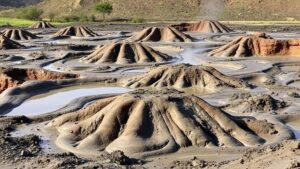Discovering the mirror-like Salar de Uyuni, the world’s largest salt flat in Bolivia.
Discovering the Mirror-like Salar de Uyuni: The World’s Largest Salt Flat
Located in southwest Bolivia, the Salar de Uyuni stands as a breathtaking natural wonder, covering an area of over 10,582 square kilometers (4,086 square miles). This vast salt flat is not only the world’s largest but also one of its most photogenic sites, often described as a mirror reflecting the sky, especially during the rainy season. Understanding the Salar de Uyuni requires a look into its formation, ecological significance, cultural heritage, and unparalleled tourist experiences.
The Formation of Salar de Uyuni
The Salar de Uyuni was formed as a result of the transformation of ancient lakes. Approximately 30,000 to 40,000 years ago, it was part of the enormous Lake Minchin, which has long since dried up, leaving behind a crust of salt known as *halite*. This natural phenomenon is comparable to a massive pancake, where the crust is thick and hardy while the underlying material remains more fluid and softer.
Today, beneath its surface lies an estimated 7 million tons of lithium, accounting for about 7% of the world’s lithium reserves. Lithium is a pivotal element in the production of batteries for electric vehicles, further increasing the interest in the area from global industries and investors alike.
Ecological Significance
Salar de Uyuni is not just significant for its size and beauty; it also plays a critical role in the local ecosystem. flat is home to a variety of wildlife, including rare species of flamingos. The three notable types of flamingos that inhabit the region include:
- The Andean flamingo (*Phoenicoparrus andinus*)
- The Chilean flamingo (*Phoenicopterus chilensis*)
- The Jamess flamingo (*Phoenicoparrus jamesi*)
These birds flock to the salt flat primarily for the brine flies and algal blooms that occupy the saline water pools. Plus, Salar de Uyunis unique landscapes foster various hardy plant species, adapted to survive in the extreme conditions.
Cultural Heritage and Local Economy
The region surrounding Salar de Uyuni is rich in cultural heritage and history. Local Aymara and Quechua communities have inhabited the area for centuries, relying on traditional agriculture and salt extraction as their primary means of livelihood. The salt mining industry, although small-scale, has historical roots in pre-colonial times and remains vital to the local economy today.
In 1990, the Bolivian government declared the area a National Park and UNESCO World Heritage site, emphasizing the importance of protecting this unique ecosystem. Tourists flock to the region, contributing to eco-tourism and providing a sustainable income for local communities.
Tourism: A Spectacular Experience
While visitors can explore Salar de Uyuni throughout the year, the best time to witness its stunning mirror effect typically occurs between November and March, during the rainy season. As rainwater collects on the flat, it creates a reflective surface that has garnered global attention, making it a favorite subject for photographers, artists, and travel enthusiasts.
Popular activities at Salar de Uyuni include:
- Salt flat tours in 4×4 vehicles
- Visiting the iconic Incahuasi Island, known for its giant cacti
- Admiring the sunset and stargazing in one of the world’s darkest locations
Also, the nearby salt hotels, made entirely of salt blocks, offer unique accommodations for visitors. These establishments not only provide comfort but also showcase the rich traditions and resources of the region.
Real-World Applications and Conclusion
The allure of Salar de Uyuni extends beyond its breathtaking views. As one of the most significant lithium reserves globally, the salt flat has attracted attention from technology and automotive companies who aim to source lithium for sustainable energy solutions. As electric vehicles become more prevalent, the strategic importance of Salar de Uyuni may increase, resulting in potential economic growth and challenges related to resource management and ecological preservation.
To wrap up, a visit to Salar de Uyuni is an enriching experience, combining natural beauty with ecological importance and cultural significance. Whether basking in the vibrant reflection during the rainy season or exploring the rugged landscapes year-round, this salt flat offers a profound connection to nature, and an understanding of the intricate balance between human activities and environmental stewardship. Embrace the chance to explore this marvel, and witness firsthand the breathtaking spectacle that defines Bolivia’s Salar de Uyuni.


